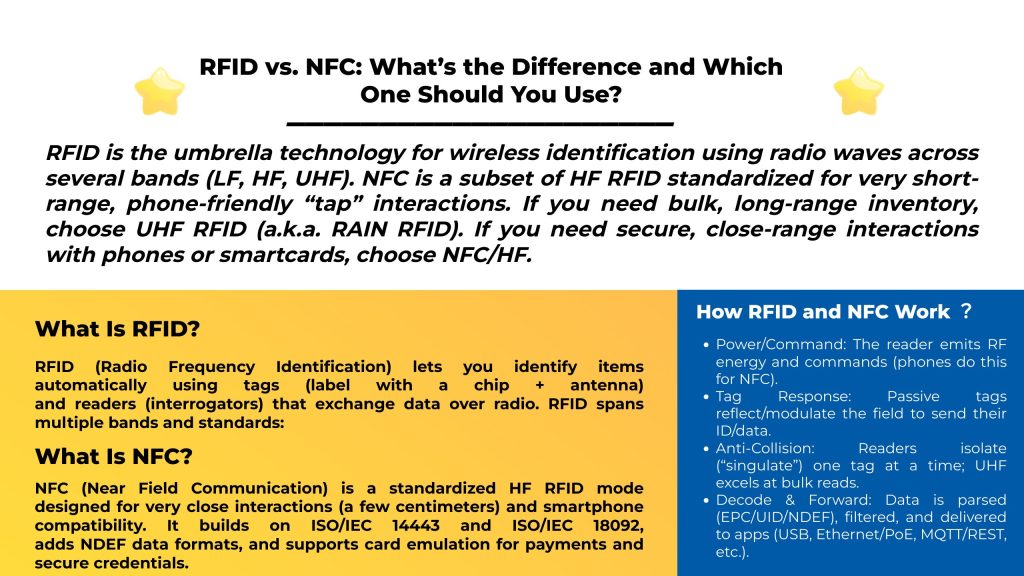

RFID is the umbrella technology for wireless identification using radio waves across several bands (LF, HF, UHF). NFC is a subset of HF RFID standardized for very short-range, phone-friendly “tap” interactions. If you need bulk, long-range inventory, choose UHF RFID (a.k.a. RAIN RFID). If you need secure, close-range interactions with phones or smartcards, choose NFC/HF.
| Aspect | RFID (General) | NFC (Subset of HF RFID) |
|---|---|---|
| Frequencies | LF 125/134.2 kHz, HF 13.56 MHz, UHF 860–960 MHz | 13.56 MHz (HF only) |
| Typical Range | HF: a few cm to ~1 m (optimized 15693) • UHF: several meters (10–20 m tuned) | A few cm (tap) |
| Read Many at Once | Yes (anti-collision; especially strong in UHF) | Limited; typically one-to-one |
| Smartphone Support | Phones do not read UHF; need a UHF sled/reader | Native on modern phones (NFC) |
| Primary Data Models | EPC (UHF), UID/blocks (HF), user memory | NDEF records; card emulation |
| Best For | Logistics, inventory, portals, WIP, assets | Payments, access badges, tickets, consumer engagement |
| Tag Cost | UHF labels: very low cost at scale | NFC tags/cards: low–medium |
| Security Options | UHF: passwords, optional crypto suites | NFC/HF: mature crypto & mutual auth options |
| Environment & Materials | UHF sensitive to metal/liquids (mitigate with on-metal tags/antenna strategy) | HF more tolerant near liquids/metal at very short range |
RFID (Radio Frequency Identification) lets you identify items automatically using tags (label with a chip + antenna) and readers (interrogators) that exchange data over radio. RFID spans multiple bands and standards:
NFC (Near Field Communication) is a standardized HF RFID mode designed for very close interactions (a few centimeters) and smartphone compatibility. It builds on ISO/IEC 14443 and ISO/IEC 18092, adds NDEF data formats, and supports card emulation for payments and secure credentials.
Key takeaway: All NFC is RFID, but not all RFID is NFC.
| Band | Core Standards | Typical Range* | Typical Uses |
|---|---|---|---|
| LF 125/134.2 kHz | ISO 11784/11785 | up to ~10 cm | Animal ID, tools |
| HF 13.56 MHz (Proximity) | ISO/IEC 14443 A/B | ~10 cm | Cards, badges, payments |
| HF 13.56 MHz (NFC) | ISO/IEC 18092 + NFC Forum | Tap (few cm) | Phones, consumer taps |
| HF 13.56 MHz (Vicinity) | ISO/IEC 15693 | tens of cm to ~1 m (optimized) | Libraries, labs |
| UHF 860–960 MHz (RAIN RFID) | ISO/IEC 18000-63 / EPC Gen2 | Several meters (10–20 m tuned) | Logistics, inventory, portals |
*Real-world distance depends on tag design/orientation, antenna gain/polarization, environment, and regional power limits.
| Requirement | Best Fit | Why |
|---|---|---|
| Read hundreds of moving items at once | UHF RFID | Anti-collision + long range |
| Tap-to-interact with a smartphone | NFC/HF | Native in phones; great UX |
| Secure door access with badges | HF/NFC | Mature crypto & readers |
| Vehicle gate or long-range entry | UHF RFID | Meter-level range |
| On-metal equipment tracking | UHF (on-metal tags) or HF | Form-factor + environment |
| Consumer engagement on packaging | NFC (optionally + UHF) | One tap to a URL/app |
| Item-level retail inventory | UHF RFID | Speed + cost at scale |
Is NFC the same as RFID?
NFC is a subset of HF RFID designed for very short-range, phone-friendly interactions. RFID also includes UHF for long-range bulk reads.
Can my phone read UHF RFID tags?
No, not natively. Phones read NFC. To read UHF, use a Bluetooth/USB UHF reader or a dedicated handheld.
Which has better security—RFID or NFC?
For tap-based credentials and payments, NFC/HF offers mature cryptography. UHF supports passwords and optional crypto; system-level security (TLS, signed firmware, access control) is essential.
How far can each read?
NFC/HF: a few centimeters (14443) to tens of centimeters (~15693 optimized). UHF: several meters, up to ~10–20 m in tuned conditions.
Can I use both on the same product?
Yes. Many brands combine UHF for logistics with NFC for customer engagement and after-sales.
Tell us your range, environment, item type, and region; we’ll recommend the right reader + antenna plan or an OEM/ODM variant.
If you are interested in our services or need customized solutions, please feel free to contact us.